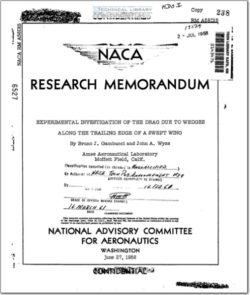NACA-RM-A58D15

- Version
- 170 Downloads
- 474.46 KB File Size
- 1 File Count
- December 4, 2015 Create Date
- December 4, 2015 Last Updated
National Advisory Committee for Aeronautics, Research Memorandum - Experimental Investigation of the Drag Due to Wedges Along the Trailing Edge of a Swept Wing

A wind-tunnel investigation was conducted to determine the drag
increment due to the superposition of wedges with various plan-form
shapes along the trailing edge of a sweptback wing. Data were obtained
at a model angle of attack of OO and a Mach number range of 0.60 to 1.15.
Reynolds number varied from 6,000,000 to 7,000,000.
Trailing-edge wedges similar to two sets reported on herein have
been used on the control surfaces of unswept wings to alleviate or elim-
inate unstable aerodynamic damping at subsonic Mach numbers. All the
trailing-edge wedges tested increased the drag over that of the basic
wingAbody combination. Drag computations indicated the possibility of
reducing the transonic drag rise by contouring the body.
The investigation reported in reference 1 revealed that triangular-
shaped wedges placed on a control surface eliminated unstable aerodynamic
damping and thereby prevented a single-degree-of-freedom flutter from
occurring at subsonic speeds. However, an increase in environmental
pressure fluctuations was observed, indicating that the wedges increased
buffeting. Also, it is evident that drag penalties could be associated
with the addition.of the wedges. Because of the method of installation
of the model for reference 1, drag measurements were not obtained. It
is the purpose of this investigation to determine the magnitude of the
drag penalty associated with various trailing-edge wedge configurations
that may alleviate or eliminate control-surface flutter (see refs. 1
and 2). Data are presented for six trailing-edge modifications.
The basic model is illustrated in figure 1. The wings had an aspect
ratio of 3, a taper ratio of 0.h, a leading—edge sweep angle of h5.3°,
and modified NACA 6hAOO6 sections perpendicular to a line sweptback
39.h5° which was the quarter-chord line of these sections. The body was
a Sears-Haack body and had a closed fineness ratio of 12.5. A complete
description of the wingébody combination is given in reference 3.
The model was mounted in the wind tunnel by means of a sting, and
the drag force was measured as an electrical output from a strain-gage
balance located within the model. A photograph of the model support
system is shown in figure 2.
| File | Action |
|---|---|
| naca-rm-a58d15.pdf | Download |

Comment On This Post